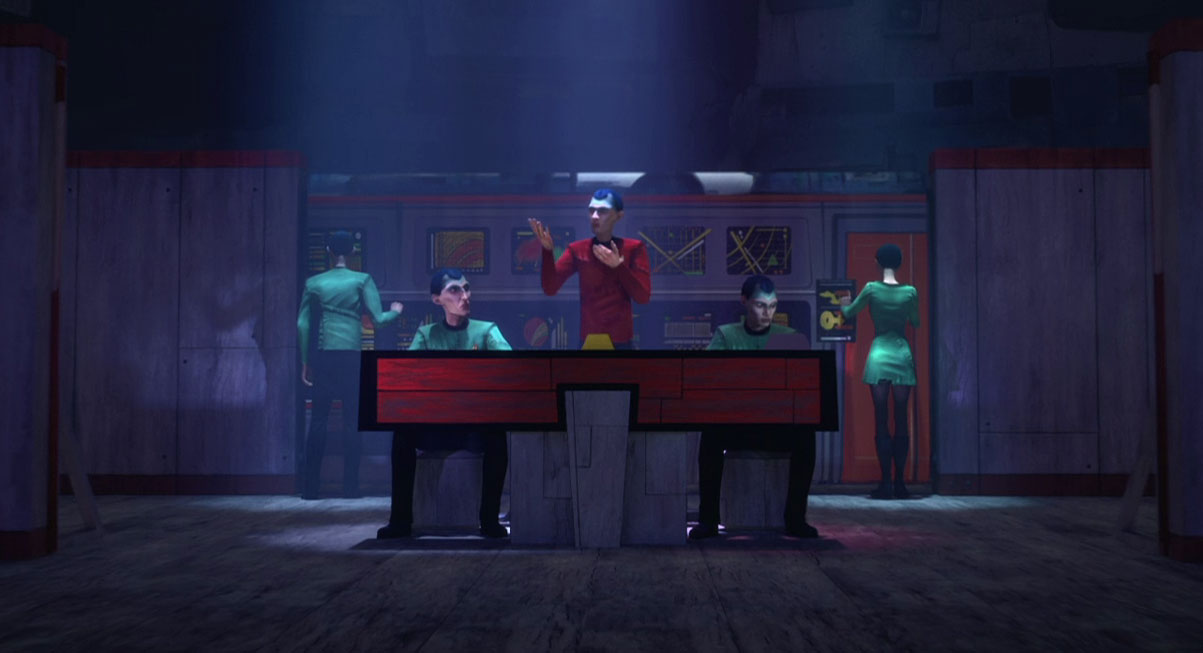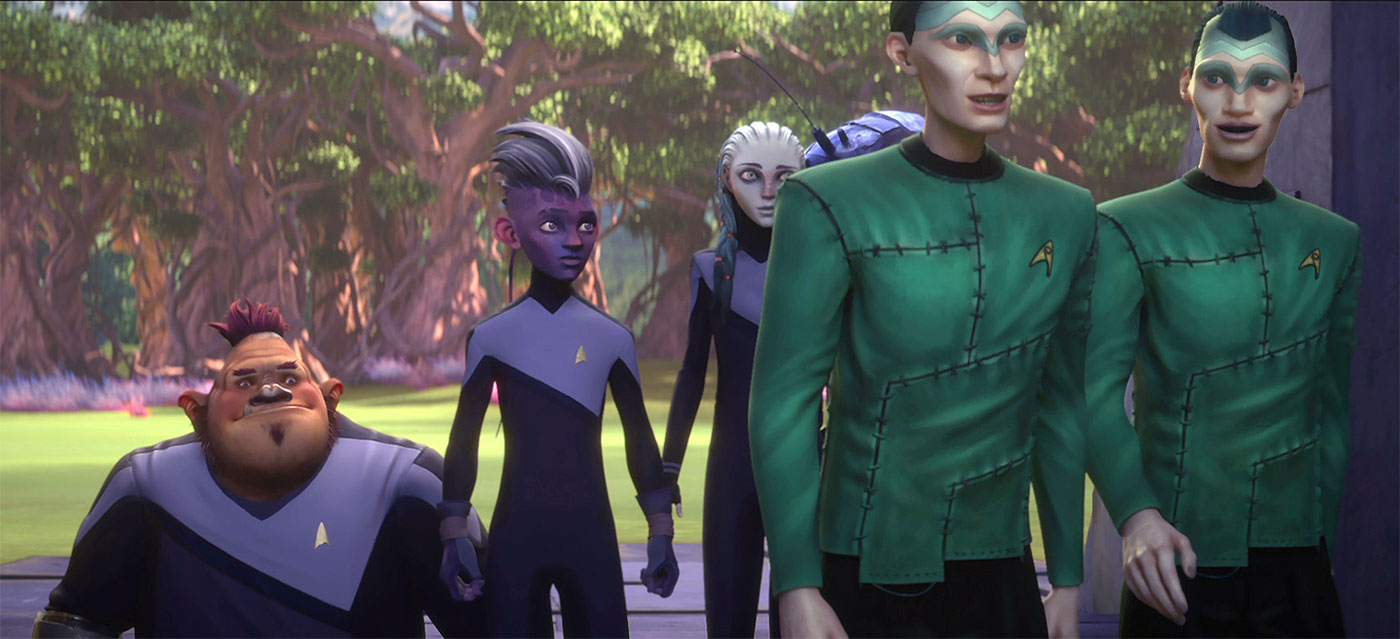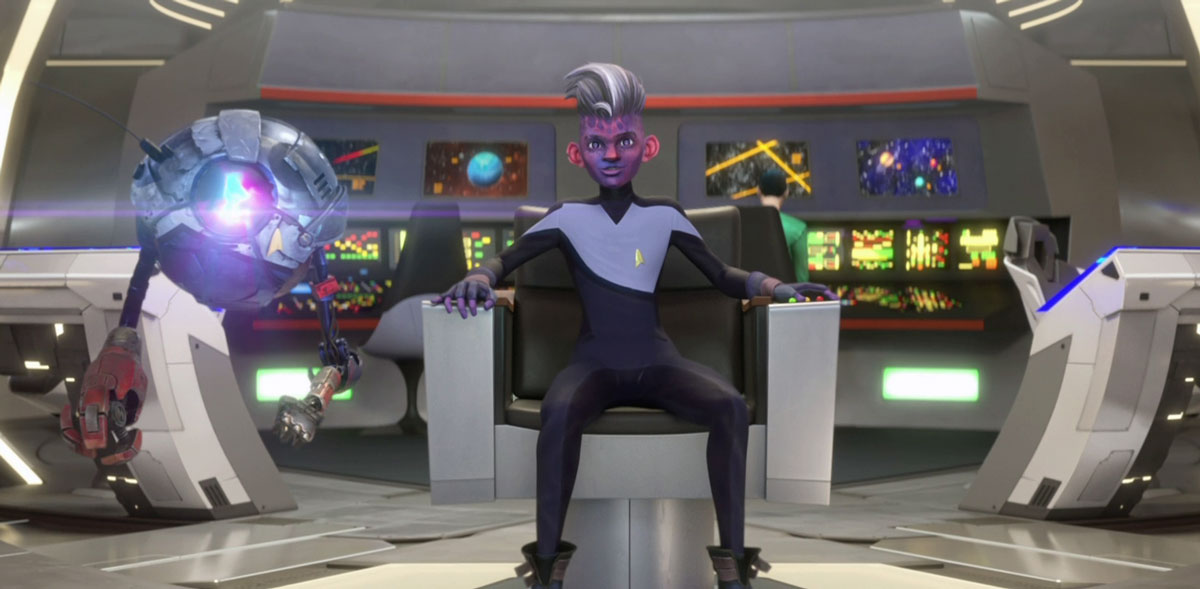Like last year’s “Kobayashi,” Star Trek: Prodigy brought viewers another high-concept episode of the animated series to fans last week — as Dal and the Protostar crew encountered a colony heavily influenced by Captain Kirk and company in “All the World’s a Stage.”
In the first half of a two-part interview with Prodigy co-executive producer and Season 2 co-head writer Aaron Waltke, who scripted the November 10 episode, we learn about the wayward Enterprise ensign who landed on the distant planet, balancing adult and child-friendly storylines, meta Trek tales, and more.
TREKCORE: “All The World’s a Stage” is just so fun and so meta. How did the high-concept of a society being corrupted in this way come about as an idea for an episode?
AARON WALTKE: Well, whenever we sort of brainstorm high concept ideas for Star Trek: Prodigy — or really, anything the Hagemans and I work on — we always sort of have this wish list of fun stuff we wanna see. And in the case of Star Trek: Prodigy, part of that was about the Star Trek concepts we wanted to put our own spin on.
And you know, one of them was of course, the TOS sort of cultural contamination episode, probably best represented by episodes like “A Piece of The Action” where they left a dime-store gangster novel behind on another planet, and then somehow, you know, fast forward 100 years, the entire world is like 1930 Chicago.
It’s such a crazy idea that enthralled me as a kid, watching the reruns on TV. I was literally on the edge of my seat. Like, “How did this happen and how do they get out of this?” It was such a wild, bold swing that I feel like the Original Series was so known for.
So we had that sort of floating in the back of our heads, and then, we would have sort of brainstorming sessions that we call ‘blue-sky brainstorming,’ where we would all just sort of come up with one-off ideas. Diandra Pendleton-Thompson, one of our staff writers, just wrote the phrase on the board, “All the world’s a stage,” because she comes from a theatrical background.
And then she wrote, “They arrive on a planet, and they’re acting out captain’s logs.” My imagination was immediately piqued by that, because I was like, “First of all, ‘all the world’s a stage’ sounds like a TOS episode, with their penchant for Shakespeare.” Then also, the wheel started spinning in my head of like, “Well, how would they get a hold of these logs?” — and then it spun out from there, and slowly built to this idea similar to how “Kobayashi” didn’t start with bringing back a bunch of cameo characters, it started with the idea of putting Dal through the Kobayashi Maru test.
In this case, what better way to kind of see how Star Trek has evolved — and the definition of what a Starfleet crew is — than to see copy-of-a-copy facts become myth, and the myth become legend, that might strike both the viewers at home and our Prodigy crew as somewhat alien, but also, through the course of the episode, realize just how big and diverse and interesting the greater Star Trek family is.
They could be called landing parties or away teams, they could be using duotronic processors or isolinear chips, but really, as long as you stay true to the heart of Starfleet, which is venturing out, seeking out that new horizon and boldly going where no one has gone before, and a willingness to help others, wherever you can, then you’re as much Starfleet as the next person.
And I think that applies as much to the viewers at home, too, that maybe aspire to these grand ideals of imperfect but striving for perfection future, but not seeing much of that here on earth today. And the way we get there is belief. Belief that we can be our better selves.
TREKCORE: How much fun was it to break out all the examples of almost-correct Original Series references?
WALTKE: Believe it or not, that mostly just kind of dumped out of my brain as we were talking out like, “What is this society? How much do they know?” I channeled a little bit of Mad Max: Beyond Thunderdome, which is, as weird of a movie that is, it’s one of my absolute favorites, and the whole Mad Max franchise, really. But also just finding what’s the correct version — and then how do you put like a little tweak on it where it could mean something similar, but not quite, like a game of telephone. I don’t know where I got a lot of it from. It just kind of bubbled up from some hidden part of my brain
TREKCORE: And specifically using Ensign Garrovick from “Obsession,” how did you land on using him as the impetus for the colony’s backstory?
WALTKE: As were kind of chalking out who would stick around to teach them enough about Starfleet, but then ultimately be left there, we thought that a “redshirt” would be the right choice — and we started talking about which TOS redshirt would fit the bill.
Somebody brought up that it could be Ensign Garrovick, who was a really interesting character. He’s one of the few background characters that had a full sort of arc to themselves. “Obsession” was like a Kirk-Garrovick episode, and you’re almost ready for him to like sit down next to Chekov and just join the bridge crew at the end… and then he was never seen again.
And what was interesting about that episode in particular is Garrovick was sort of dealing with his own sort of impostor syndrome of “Oh, I chickened out. Am I really worthy of Starfleet?” So, in a weird way, it’s sort of a mirror of what our crew in the 24th century were going through. Now, the average viewer that’s just casually watching this might not pick that up, but I love those little moments where the stories can rhyme.
And it just felt deeply appropriate. The other bit of kismet was that Garrovick, might be one of the few minor redshirts to have ever survived an away mission. But then he disappeared afterwards. What happened to Garrovick? Did he die after all? And so, whether you call that final destination or what for redshirts, I think that I wanted to give him sort of a bit of a heroic sort of ending — where you got the sense that maybe a little bit of Kirk did rub off on him after all post-“Obsession.”
TREKCORE: How long was Garrovick with the people on the planet before he passed away?
WALTKE: I think that we say in the play — and obviously, you have to take that with a grain of salt — that he was there with them several months, teaching them what he could. I think with the hope that he could give them enough knowledge that they would be able to handle this rather complex Star Trek problem before it drove them to extinction. And to a certain degree, he was right.
In a way, it was sort of like intentional cultural contamination where he’s like, “I have no other way to save these people that saved me, but I’ll teach them what I know — and hope that the natural process of social evolution, they will eventually figure out what’s going on, and be able to solve the problem for themselves.”
But I think what’s also implied is they are sort of an oral storytelling society. So, inevitably, even if they didn’t have a written language, but it was more like oral or symbols or something like that, which we’ve seen societies like that, like the Tamarians then, you know things are gonna get a little bit wrong — but they got the important stuff, right?
TREKCORE: Is it just a coincidence that you’ve ended up writing the most meta episodes? Or is that by design?
WALTKE: I promise, I can write a normal Star Trek episode too! [laughs] It just happens to be that the two that kind of fell on my shoulders were the ones that I was probably the most equipped to take on. I tend to really enjoy the so-called “layer cake” episodes, where there’s, you know, five themes going at once, but they all kind of speak to each other, or maybe rhyme with each other.
And this is a super deep dive into Star Trek, and you gotta just know it top to bottom, because every single line kind of matters, in that regard. As for why I keep writing Enterprise bridges into my scripts, I don’t know. I have a problem. [laughs] I just wanna see them! And it still gets me whenever I see them in either episode. Like, yes, make the Protostar have a Constitution-class bridge, please! I love it.
TREKCORE: You mentioned having a wish list. How do things move from the wish list onto the show — what’s the process for deciding what to include?
WALTKE: So you have a wish list, and then we have what are called “bills to pay,” which is shorthand for character work that we need to have for this to work as a story. And you know, it’s not about leaning on one or the other; I’ve found over the years, that it’s a nice balance of both. We literally had lists of cards on two walls — our wish list wall, and our bills-to-pay wall — and then we would take those cards off of the wall and we would just sort of play.
Now, which of these fun concepts would actually work as a great metaphor for that, and overlay and inform that? And it’s strange alchemy, where when we just talk it out and giving yourself room to play, you just find those little overlaps, where they actually work and marry together. In this case, I think the idea that the crew is sort of going through impostor syndrome, and then we found this idea of a whole planet of people that seem to be impostors? It was kismet.
TREKCORE: Prodigy explores some pretty emotionally heavy things sometimes — how do you approach bringing those themes to the level of a young viewer?
WALTKE: I think it’s fair to say that we try not to not shy away from it, and just sort of confront it head on — because as much as adults maybe don’t like to think about it, kids and teenagers experience all of this too, in some form or another. Especially the nature of impostor syndrome, I think that that’s the most coming of age thing you could possibly go through.
So, in particular, the arc of Dal and our characters now that they’ve discovered that there’s this Living Construct weapon in their ship — and that the possibility that they could ever go back to Starfleet is in question — they’ve decided to try to still uphold the beliefs of Starfleet. But they’re not really Starfleet, and they ask themselves, “Can we really live up to this?”
Confronted by the colonists who seem to be going through that themselves, Dal sees a version of himself in that, and he doesn’t like it. So at first, he’s sort of dismissive of the Enderprizians — but in the end, that was Dal’s mistake. Realizing that in fact, there was a shining example to be learned from them: even if your circumstances thrust you into something that maybe you don’t have everything that Starfleet provides, you can still believe in it’s ideals and do good.
I think that’s as much my experience as well, as a Star Trek fan. I didn’t see much of the Starfleet I wanted to see in the world around me on Earth, but the only way we’re gonna get there is if we kind of just try to be our best Starfleet selves — and be better wherever we can.
This interview has been condensed and edited for clarity.
![]()
Star Trek: Prodigy will return with “Crossroads” on Thursday, November 17 on Paramount+ in the United States, and on November 18 in Latin America, Australia, Italy and the U.K. The series will arrive in France, Germany, Switzerland, and Austria in December.





